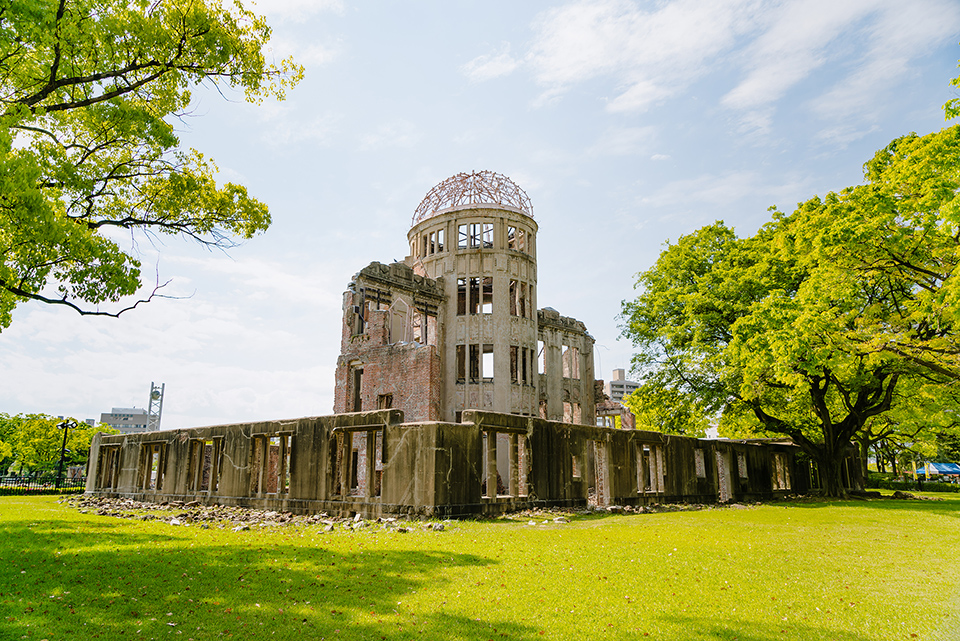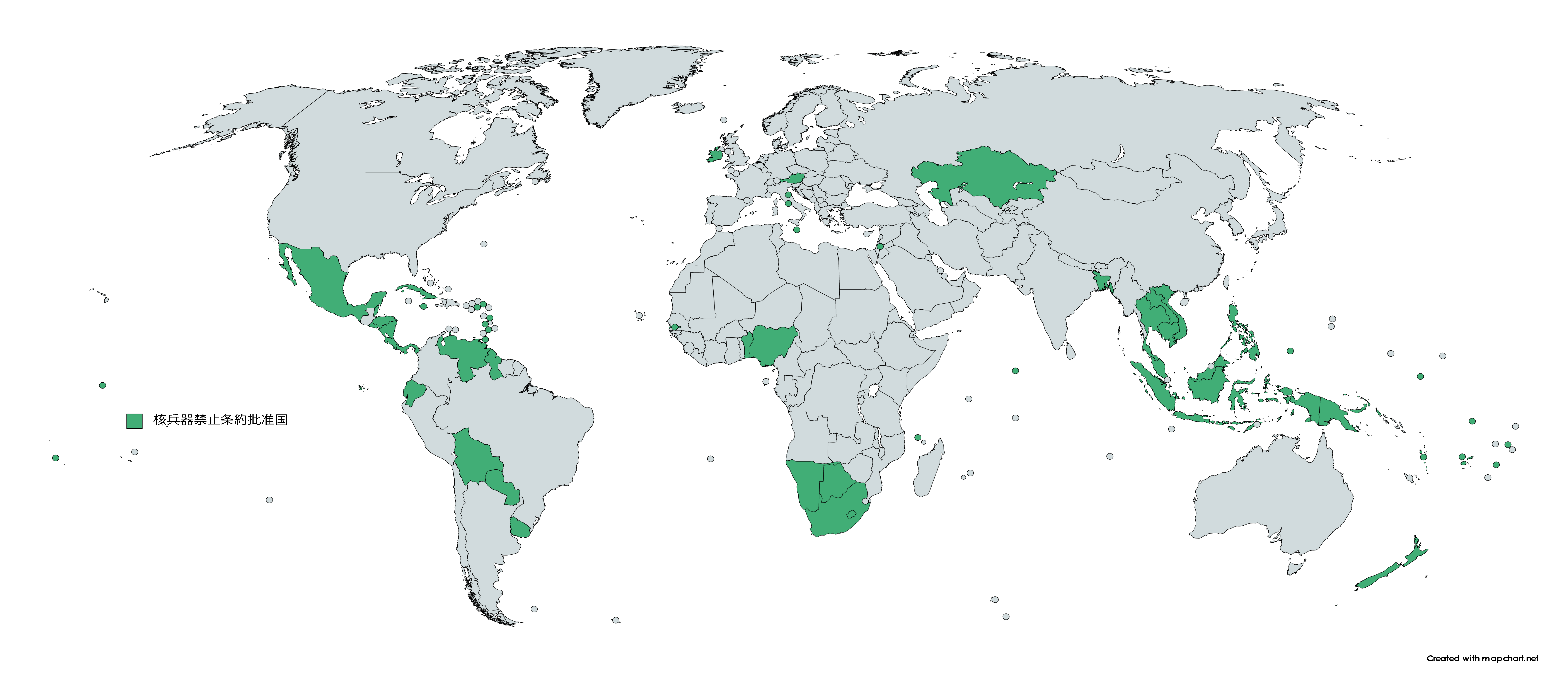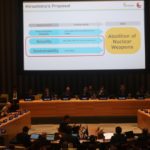“The Beginning of a World Without Nuclear Weapons!”: Event to Commemorate Enactment of the Treaty on the Prohibition of Nuclear Weapons
“The Treaty on the Prohibition of Nuclear Weapons (TPNW) was finally enacted yesterday!”
“The Beginning of a World Without Nuclear Weapons!” event, held on January 23, 2021 (Sat.), started with the ringing out of that proclamation. The 50 countries necessary to make the treaty effective ratified it on October 24, 2020, and 90 days later, on January 22, TPNW took legal effect as a global standard. To memorialize the occasion, Tokyo, Hiroshima, and Nagasaki connected online, and the event to celebrate the treaty’s enactment and once again share the vow to abolish nuclear arms commenced.

First, at the start of the event, a video was broadcast from the venue in Tokyo. The video centered on well-wishes bestowed on the treaty’s enactment from all corners of the world, continuing with comments from NAKAMITSU Izumi, United Nations Under-Secretary General and High Representative for Disarmament Affairs; Elayne Whyte Gómez of the Costa Rican Ministry of Foreign Affairs, chair of the United Nations negotiations to establish the TPNW in 2017; Peter Maurer, President of the International Committee of the Red Cross (ICRC); and Beatrice Fihn, Executive Director of the International Campaign to Abolish Nuclear Weapons (ICAN). In addition to giving their blessing, everyone paid respect and gave thanks for the actions of the atomic bomb survivors who tirelessly continued to raise their voices. The video concluded with the appearance of one of those survivors, Setsuko Thurlow, who said, “We will continue to follow the path from the TPNW to their complete abolition, along with our beloved deceased, so we can keep moving forward with courage and strength.” More real voices of atomic bomb survivors were featured, and there was coverage of the efforts leading to enactment of the treaty.

The event transitioned to an original program at the venue in Hiroshima from that point. Following speeches from the governor of Hiroshima Prefecture and the mayor of Hiroshima City, two people representing the survivors of the atomic bombing took the stage. The enactment of the treaty was portrayed as a “moment presenting a glimmer of hope,” and there was occasion to salute the 210,000 people from Hiroshima and Nagasaki who came to a brave end 75 years ago.

The program at the Hiroshima venue was distinct for inviting both bombing survivors who have driven the movement to eliminate nuclear weapons up to now and young people of the generation that bears that responsibility for the future. In the second half of the event, titled “The Young People to Whom the Atomic Bomb Survivors Will Pass the Torch,” there were speeches by and discussion among the youth present. The participants were five Hiroshima students involved in peace-related activities. They presented on peace activities they had worked on firsthand; for example, speaking about the many realizations they gained in creating and staging a play about the atomic bomb in their high school drama club or sharing episodes from when they took part in the 2020 Students’ Hiroshima Declaration, which selected university and graduate students from six countries to discuss peace. While the participants bandied questions back and forth during the talk, it ended with one future-oriented, positive remark after another about what actions they would like to take going forward.

The event then staged a reading of “That Night” accompanied by guitar, a poem about the atomic bombing; continued with footage from Hiroshima Municipal Higashino Elementary School’s choir; and finished with a commemorative photo connecting Hiroshima, Tokyo, and Nagasaki.
Many people gave speeches during the event, but along with joy at the enactment of the treaty, what was of course ultimately discussed was that this is only the beginning. Although participants praised the enactment of the treaty as one accomplishment, they also said they would make this a step toward asking the Japanese government to sign and ratify the treaty and once again encouraged one another to work hard together in order to truly achieve a world without nuclear weapons.

After the event ended, SUGANO Kazuma (Hiroshima University Graduate School), one of the onstage presenters, said, “I feel a sense of honor and great responsibility at having been able to celebrate the enactment of the world’s first nuclear weapons convention in the place where an atomic bomb was dropped for the first time in the world. I have a new understanding of the central role placed on my generation to continue these efforts in the future.”
HARADA Mahiru (Hiroshima Municipal Motomachi Senior High School) said, “I’d be delighted if the ‘Pictures of the Atomic Bombing Drawn with the Next Generation’ project I participated in became even a small part of what led to the enactment of the treaty. My goal is to be a teacher of peace and art in the future, and I would also like to be someone who passes on the experience of the people who lived through the atomic bombing.”
Being witness to this day of celebration was a fresh start for everyone, and the event gave everyone a sense of the continuing succession of memory and experience from the atomic bomb survivors to the youth.

SUGANO Kazuma is in the first year of a master’s program at Hiroshima University Graduate School. He has experience as an intern at the non-profit organization ANT-Hiroshima, which promotes worldwide peace-building.

HARADA Mahiru is a third-year student at Hiroshima Municipal Motomachi Senior High School. She participated in the “Pictures of the Atomic Bombing Drawn with the Next Generation” project, in which students listen to stories from atomic bomb survivors and express them in pictures, two years in a row.
[Interview] The Treaty on the Prohibition of Nuclear Weapons
Regarding the TPNW, we interviewed Ms. NAKAMURA Keiko, Associate professor at the Nagasaki University Research Center for Nuclear Weapons Abolition (RECNA)
Peace Learning
“What is the Treaty on Prohibition of Nuclear Weapons (TPNW)?”
What does the treaty prohibit? Is there anything we can do? This article answers those questions and introduces the treaty, as well as the efforts of Hiroshima Prefecture.
“What is the Treaty on Prohibition of Nuclear Weapons (TPNW)?”
States that have ratified/signed the Treaty on the Prohibition of Nuclear Weapons
What kind of states have ratified/signed the Treaty on the Prohibition of Nuclear Weapons? This webpage compiles a list of the ratifying/signatory nations.
States that have ratified/signed the Treaty on the Prohibition of Nuclear Weapons
Tags associated with this article






